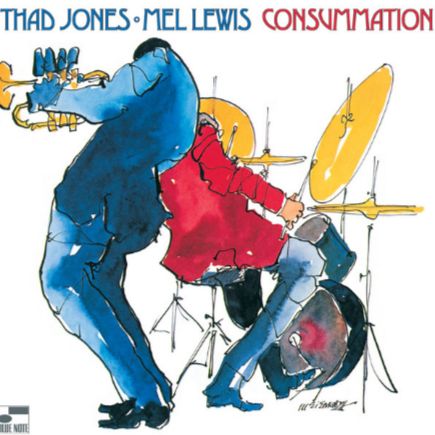Thad Jones, l’art raffiné de l’écriture orchestrale
Trompettiste, compositeur, arrangeur et chef d’orchestre, Thad Jones fait partie de ces figures du jazz dont l’influence, parfois plus discrète que celle de ses contemporains, s’est révélée déterminante. Frère du pianiste Hank Jones et du batteur Elvin Jones, il incarne à lui seul l’extraordinaire héritage musical de cette fratrie.
Autodidacte, il devient musicien professionnel dès l’âge de seize ans, se produisant avec son frère Hank et le saxophoniste Sonny Stitt. Très vite, sa polyvalence instrumentale — il maîtrise la trompette, le cornet, le bugle et le trombone à pistons — s’accompagne d’un talent exceptionnel d’arrangeur et de chef d’orchestre.
Entre 1950 et 1953, Thad Jones rejoint le quintette de Billy Mitchell, puis l’ensemble de Charles Mingus entre 1953 et 1954. Mais c’est à partir de 1954 que sa carrière prend une dimension majeure: il entre dans l’univers de Count Basie, pour lequel il compose et écrit des arrangements durant près de neuf ans. Son écriture élégante et inventive enrichit considérablement le répertoire du Count Basie Orchestra, mêlant tradition swing et modernité hard bop.
Au cours des années 1960, Thad Jones développe une activité intense comme chef de formation. Il codirige un quintette avec le saxophoniste Art Pepper, puis collabore étroitement avec le batteur Mel Lewis au Village Vanguard, haut lieu du jazz new-yorkais.
De cette rencontre naît en 1965 le Thad Jones/Mel Lewis Orchestra, un big band qui va renouveler en profondeur l’écriture orchestrale dans le jazz. Pendant douze ans, cette formation devient une référence, offrant chaque lundi soir au Village Vanguard une véritable leçon de cohésion et de créativité collective. Leur album Live in Munich (1978) leur vaut un Grammy Award en 1979, consacrant l’importance de leur démarche artistique.
En 1978, Thad Jones s’installe à Copenhague, rejoignant une communauté de musiciens américains ayant trouvé en Europe un espace d’expression privilégié. Il y fonde le groupe Eclipse, écrit pour le big band de la radio danoise et enseigne au Conservatoire royal de Copenhague, transmettant son savoir à une nouvelle génération de musiciens. Sa réputation de pédagogue, conjuguée à son expérience de compositeur et d’arrangeur, lui confère un rôle central dans le développement du jazz en Europe du Nord.
Thad Jones, el arte refinado de la escritura orquestal
Trompetista, compositor, arreglista y director de orquesta, Thad Jones forma parte de esas figuras del jazz cuya influencia, aunque a veces más discreta que la de sus contemporáneos, resultó decisiva. Hermano del pianista Hank Jones y del baterista Elvin Jones, encarna por sí solo el extraordinario legado musical de esta familia.
Autodidacta, se convirtió en músico profesional a los dieciséis años, actuando con su hermano Hank y el saxofonista Sonny Stitt. Muy pronto, su versatilidad instrumental —dominaba la trompeta, el cornetín, el fliscorno y el trombón a pistones— se unió a un talento excepcional como arreglista y director.
Entre 1950 y 1953 integró el quinteto de Billy Mitchell, y entre 1953 y 1954 formó parte del conjunto de Charles Mingus. Pero fue a partir de 1954 cuando su carrera adquirió otra dimensión: se incorporó al universo de Count Basie, para quien compuso y escribió arreglos durante casi nueve años. Su escritura elegante e inventiva enriqueció de forma notable el repertorio del Count Basie Orchestra, combinando la tradición del swing con la modernidad del hard bop.
Durante la década de 1960, Thad Jones desarrolló una intensa actividad como líder. Codirigió un quinteto con el saxofonista Art Pepper y luego colaboró estrechamente con el baterista Mel Lewis en el Village Vanguard, un lugar emblemático del jazz neoyorquino.
De esa asociación nació en 1965 la Thad Jones/Mel Lewis Orchestra, un big band que renovó profundamente la escritura orquestal en el jazz. Durante doce años, la formación se convirtió en una referencia, ofreciendo cada lunes en el Village Vanguard una verdadera lección de cohesión y creatividad colectiva. Su álbum Live in Munich (1978) les valió un Grammy Award en 1979, consagrando la importancia de su proyecto artístico.
En 1978, Thad Jones se instaló en Copenhague, uniéndose a una comunidad de músicos estadounidenses que habían encontrado en Europa un espacio privilegiado de expresión. Allí fundó el grupo Eclipse, escribió para el big band de la radio danesa y enseñó en el Conservatorio Real de Copenhague, transmitiendo su saber a una nueva generación de músicos. Su reputación como pedagogo, unida a su experiencia de compositor y arreglista, le otorgó un papel central en el desarrollo del jazz en el norte de Europa.
Thad Jones, l’arte raffinata della scrittura orchestrale
Trombettista, compositore, arrangiatore e direttore d’orchestra, Thad Jones appartiene a quelle figure del jazz la cui influenza, talvolta più discreta rispetto a quella dei suoi contemporanei, si è rivelata decisiva. Fratello del pianista Hank Jones e del batterista Elvin Jones, incarna da solo l’eccezionale eredità musicale di questa famiglia.
Autodidatta, divenne musicista professionista a sedici anni, esibendosi con il fratello Hank e il sassofonista Sonny Stitt. Ben presto, alla sua versatilità strumentale —suonava tromba, cornetta, flicorno e trombone a pistoni— si unì un talento straordinario come arrangiatore e direttore.
Tra il 1950 e il 1953 fece parte del quintetto di Billy Mitchell, e tra il 1953 e il 1954 dell’ensemble di Charles Mingus. Ma fu a partire dal 1954 che la sua carriera prese una svolta significativa: entrò a far parte dell’universo di Count Basie, per il quale compose e scrisse arrangiamenti per quasi nove anni. La sua scrittura elegante e inventiva arricchì notevolmente il repertorio del Count Basie Orchestra, fondendo la tradizione swing con la modernità dell’hard bop.
Nel corso degli anni Sessanta, Thad Jones sviluppò un’intensa attività come leader. Codiresse un quintetto con il sassofonista Art Pepper e collaborò strettamente con il batterista Mel Lewis al Village Vanguard, luogo simbolo del jazz newyorkese.
Da quell’incontro nacque nel 1965 la Thad Jones/Mel Lewis Orchestra, un big band che rinnovò profondamente la scrittura orchestrale nel jazz. Per dodici anni la formazione divenne un punto di riferimento, offrendo ogni lunedì al Village Vanguard una vera lezione di coesione e creatività collettiva. L’album Live in Munich (1978) valse loro un Grammy Award nel 1979, consacrando l’importanza della loro visione artistica.
Nel 1978 Thad Jones si trasferì a Copenaghen, unendosi a una comunità di musicisti americani che avevano trovato in Europa uno spazio privilegiato di espressione. Qui fondò il gruppo Eclipse, scrisse per il big band della radio danese e insegnò al Conservatorio Reale di Copenaghen, trasmettendo il proprio sapere a una nuova generazione di musicisti. La sua reputazione di pedagogo, unita all’esperienza di compositore e arrangiatore, gli conferì un ruolo centrale nello sviluppo del jazz nell’Europa settentrionale.
Thad Jones, the refined art of orchestral writing
Trumpeter, composer, arranger, and conductor, Thad Jones belongs to that group of jazz figures whose influence, though sometimes less visible than that of his contemporaries, proved to be decisive. Brother of pianist Hank Jones and drummer Elvin Jones, he embodied the extraordinary musical legacy of this remarkable family.
Largely self-taught, he became a professional musician at the age of sixteen, performing with his brother Hank and saxophonist Sonny Stitt. His instrumental versatility—he mastered the trumpet, cornet, flugelhorn, and valve trombone—was soon matched by an exceptional gift as an arranger and bandleader.
Between 1950 and 1953, Thad Jones played with Billy Mitchell’s quintet, and from 1953 to 1954 he was a member of Charles Mingus’s ensemble. But from 1954 onward, his career reached a new dimension when he joined Count Basie, composing and arranging for nearly nine years. His elegant and inventive writing greatly enriched the repertoire of the Count Basie Orchestra, blending swing tradition with hard bop modernity.
During the 1960s, Thad Jones was highly active as a leader. He co-led a quintet with saxophonist Art Pepper and worked closely with drummer Mel Lewis at the Village Vanguard, a landmark of New York jazz.
From this collaboration emerged the Thad Jones/Mel Lewis Orchestra in 1965, a big band that profoundly renewed orchestral writing in jazz. For twelve years, the ensemble became a reference point, offering every Monday night at the Village Vanguard a true lesson in cohesion and collective creativity. Their album Live in Munich (1978) earned them a Grammy Award in 1979, affirming the importance of their artistic vision.
In 1978, Thad Jones moved to Copenhagen, joining a community of American musicians who had found in Europe a privileged space for expression. There, he founded the group Eclipse, wrote for the Danish Radio Big Band, and taught at the Royal Danish Conservatory, passing on his knowledge to a new generation of musicians. His reputation as a pedagogue, combined with his experience as a composer and arranger, gave him a central role in the development of jazz in Northern Europe.



